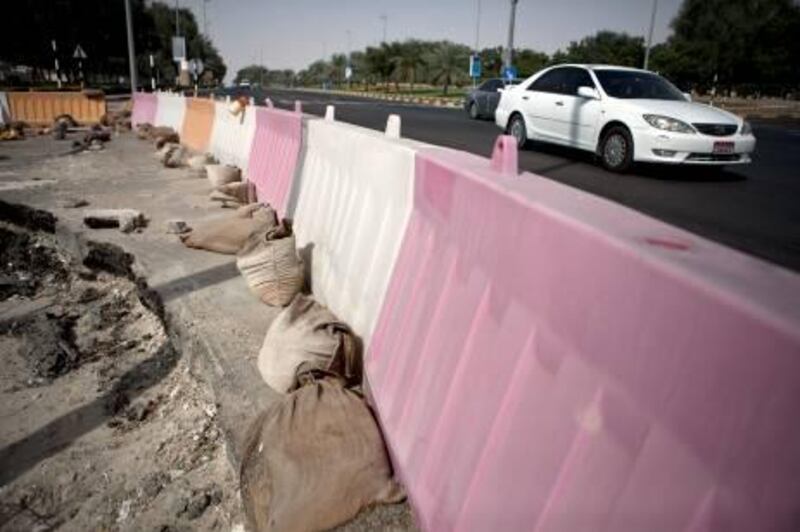MADINAT ZAYED // Traffic engineers are working to make roads safer in the country's most dangerous region, where the population is expected to double by 2030.
Although road deaths dropped by 26 per cent in 2011 from 2010, the western region's lightly patrolled, unlit roads remain the country's most notorious.
Crash rates in Al Gharbia are three times higher than the average for the entire Abu Dhabi emirate.
Engineers and response services want to cut death rates in half by 2020, before the economy and population boom hits.
The Health Authority-Abu Dhabi reported 98 deaths in Al Gharbia in 2010, an incident rate of 67.82 deaths per 100,000 population, more than four times the emirate average of 16.17.
In 2011, there were 72 deaths, and an incident rate of 48.4 deaths per 100,000.
Last year, for example, a single a collision between a bus and a minivan in Ruwais killed several workers.
More must be done before the population grows, engineers have warned.
"With the plans for the population increase there will be a lot of economic activity which will translate into more trips," said Abdenacer Boutemine, the road division manager for the Western Region Municipality. "It's our responsibility to manage this growth intelligently."
A full inventory of Al Gharbia's 800 kilometres of roads has been completed and the entire network is to be improved within 10 years.
This will be a crucial part of the economic development expected to follow industrial projects that include the Dh36.7bn Ruwais refinery expansion and the Dh73.5bn nuclear reactor project in Braka.
Al Gharbia's roadworks are a priority for Abu Dhabi's Urban Planning Council, which has completed master plans for the emirate running through 2030.
"In terms of the master plan, I think the Government is really dedicated to advancing this programme and they will supply us with the necessary funding," Mr Boutemine said. "I think it's really irreversible at this time because a lot of people have heard about the master plan, everybody is convinced that it's really necessary to develop the area, as well as the emirate and the country."
The population in Al Gharbia grew by 41 per cent from 2005 to 2010, according to the Statistics Centre Abu Dhabi, to stand at 184,508.
Under current plans, the population is expected to reach 120,000 in Ruwais by 2030, Madinat Zayed is to double to about 55,000 and even sleepy Mirfa is projected to reach a population of 65,000.
Growth, however, depends on road infrastructure.
"Development will not come without having the utilities, infrastructure and roads that will entice people into the region," said Dr Eyyad Al Khalaileh, adviser for the Western Region Development Council for infrastructure and planning. "The municipality has to take the responsibility to submit the business cases and the requirements for the whole project and when the budget gets approved they can force those projects to come online.
"One of the major issues that the western region is facing is that projects are not moving forward and it's making it difficult for investors."
Engineers have called for standardised road design, new signage and lighting, and a new storm drainage system.
U-turns are to be banned entirely. In addition, they want lower speed limits and stricter enforcement.
Funding for a new Dh10bn Mafraq-Ghweifat (E11) motorway was approved by the Abu Dhabi Executive Council in January.
It is to have three lanes, be fully lit and have many turn-off sites for emergency response units.
It is hoped that the integrated traffic systems planned for Abu Dhabi city will be applied to places in Al Gharbia, such as a motorway radio system that broadcasts road conditions to motorists and radar systems that take an average speed between two points instead of relying on a single location.
Police have already increased patrols in the region by hundreds.
Recent budget approvals by the emirate's Executive Council mean many of these plans may begin soon.
The municipality is already selecting contractors after the approval of road infrastructure funding in recent weeks.
These include Dh3million for road safety infrastructure to be allocated to six communities, road networks for two residential neighbourhoods in Madinat Zayed that had waited for approval for two years, and a 25-km dual carriageway from the hamlet of Bida Al Mutawa to Ghayathi.
"The faucet has been opened," Mr Boutemine said. "There was an approval from Executive Council on many, many aspects of the budget so now we are preparing a lot of documentation to get consultants and contracting."






